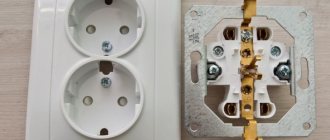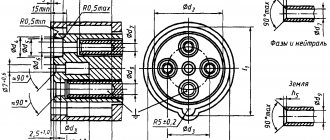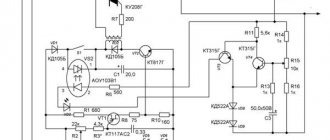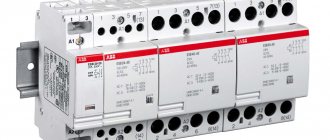Nowadays, PUE (electrical installation rules) provide for mandatory grounding of outlets in private and apartment buildings. But it was not always so. In older houses and most private sectors, a two-wire system is still used - phase and neutral. To be precise, a considerable number of electrical appliances do not require a grounding contact. Usually these are various lamps in a plastic case, televisions, and musical equipment. If the distribution board does not have a corresponding busbar or one of the listed household appliances needs to be connected to the network, you can use sockets without grounding, the cost of which is much lower. We will talk about them.
Electric networks yesterday and today
During the Soviet era, houses were built at an accelerated pace; there was not enough time to think through and arrange grounding. Moreover, such protection was useless - none of the household electrical appliances had a corresponding contact on the plug. The maximum that one could count on when moving to a new home was double sockets without grounding, which pleased with the possibility of connecting additional electrical appliances to the network.
Now everything has changed, and it has become quite difficult to find large household appliances in stores without a grounding contact. The sockets also acquired a new look, in which an additional bracket appeared, and the contact holes began to be covered with internal curtains to protect them from children. But although the usual connection points have not disappeared anywhere, they can be seen much less often. Outdoor sockets with a high IP protection class are usually installed without grounding.
Old wiring. What is the danger? Partial replacement of electrical wiring
First of all, this is a fire hazard . Secondly, it is a danger to life and health (current up to 36 volts is considered safe for humans). And thirdly, poor outdated electrical wiring means unstable operation and failure of equipment, and breakdown of expensive household and lighting fixtures.
Old aluminum wiring
How to realize that there is old wiring in the house?
First of all, you need to pay attention to the electrical panel. Typically, this is where the electricity meter is installed. If there are still old Soviet plugs in the panel, then you definitely have old wiring! Everything is obvious here, the wiring in the house is rotten, with aluminum wires (with the rare exception of Stalinist houses). The second, important sign of old electrical wiring is that you are periodically shocked in the most unexpected places.
Don't wait until next time - call an electrician! And if possible, be sure to replace all traffic jams with automatic ones. Don't wait until they burn out next time. It is best to entrust the replacement of traffic jams to automatic machines to a professional.
Remember! That untimely replacement of wiring can cost you significantly more.
“Fireproof” wooden panel with melting wires Old plugs
What are the dangers of aluminum wiring?
The lifespan of aluminum wires is significantly less than that of copper wires. Aluminum is more susceptible to oxidation and is a less flexible and softer metal (compared to copper alloys). The problem with aluminum is especially pronounced in places of connections and kinks in the wiring. High humidity and poor contact also accelerate oxidation processes. Subsequently, this leads to overheating and burnout of contacts.
aluminum wiring
Old aluminum wiring has single insulation, which is unacceptable according to modern PUE rules. Single insulation is fraught with current leakage into walls or other structures of the house. In a modern home, a double insulated wire is needed, which is called a cable. According to the new rules, only double-insulated cables are allowed to be used in apartments and houses.
How does current pass through a person?
Another disadvantage of the old wiring is the absence of a third ground wire. In old five-story buildings, Khrushchev, Stalinist, and panel houses, up to the construction of the early 2000s. - there was no grounding. Therefore, installing sockets with grounding, without replacing all the wires and rebuilding the panel, does not make any practical sense. In special, ridiculous cases, this can even play a cruel joke if the sockets are installed incorrectly. The new rules require all electrical equipment to be grounded and therefore have a safety wire in all electrical wiring. What is the term grounding and why it is needed can be read here.
Socket without ground
Solder boxes and twists
Standard location of junction boxes
In old electrical wiring, twists are the norm. Good quality twist, no worse than a bolt clamp. The main and necessary condition is that all twists and connections of wires must be located in junction boxes, which serve as a place for safe switching (connection) of wires. According to the rules, it is not allowed to block access to junction boxes, cover them up or cover them with wallpaper. Typically, junction boxes with twists are located above the light switches under the ceiling.
Horrible old twists
Twists of aluminum wires in these places become unusable over time, especially with high humidity and poor-quality installation. Signs of problems in the junction box are: blinking lights, electrical crackling under the ceiling, burning smells (not always obvious), or a partial absence of light in the apartment. In such cases, it is necessary to look for and open old junction boxes in order to sort through (reconnect). To do this, unravel the old strands and place the wires on special terminal blocks , having previously treated the ends of the wires.
Sockets with curtains: what are they for?
Such products are perfectly protected from children's curiosity. Curtains are special partitions inside the housing that block access to live contacts. In order to insert the plug into it, you need to make some effort. A little curious discoverer will not be able to stick any foreign body into it - a nail or a knitting needle. This allows parents to be calmer. Previously, special plastic plugs were used for such purposes, which were quite easily removed by the child.
Another type of such protection, although simpler, is a cover that is pressed against the body by a spring. Such products are more often used for outdoor installation, and therefore they do not have a wide range of colors. Mainly produced are gray and white external sockets without curtains with or without grounding, equipped with covers.
Concept and types
The most obvious example of grounding is a lightning rod, which conducts an electrical discharge along the path of least resistance from the highest point into the ground, bypassing the building's electrical communication systems. For high-voltage lines, lightning rods are power transmission line supports, which prevent lightning discharges from reaching the wire, thereby creating voltage drops in the network during a thunderstorm.
The second type is SPD (surge protection device). One electrode is connected to a low-voltage wire, and the other is grounded. The space between the electrodes is filled predominantly with inert gas. When a certain voltage is reached by 1–5%, lower than the maximum at which a particular device can operate, a breakdown occurs - the voltage equalizes. SPDs are used to eliminate residual voltage on network patch cables.
The third type is used for grounding in an apartment building. A neutral or additional grounding wire is used as grounding, which is supplied to each socket as an additional contact for a 220V socket or in the case of an industrial 3-phase voltage of 380V.
What does the presence of a grounding contact affect?
To connect such an outlet, certain wiring is required. There should be 3 wires approaching the connection point - phase, neutral and a yellow-green ground wire. Such sockets, when installed correctly, provide additional safety for both household appliances and people. If the grounding is done properly, and all the necessary automation is installed in the distribution cabinet, you don’t have to worry about overloads, voltage surges, and even phase breakdown on the metal body of the household appliance.
Useful video on the topic
A lot of interesting information is in the video.
Leave a comment Cancel reply
Similar posts
DIY installation of an external socket, detailed instructions
Connection diagram for a pass-through switch from three places - features, as well as installation sequence
A few simple rules for choosing sockets and switches
Height and placement of sockets in the kitchen in a modern apartment
What are the benefits of sockets without grounding?
The advantage of such products is their simplicity - the fewer components, the more reliable the mechanism. It is also worth noting the low cost of such sockets. Ease of connection will most likely play a decisive role for novice home craftsmen who are faced with this issue for the first time. However, it is necessary to understand that if the home power network provides a grounding wire, then it should not be ignored, much less cut off, as some do. Such contact at some point can save a life. Of course, it would be better if such a danger did not arise, but the Japanese (and these people are very smart) say this: “It makes sense to sharpen your sword all your life so that it can save your life just once.” A similar statement is true in the case of grounding.
How to properly connect an outlet in a dorm if the wiring is not grounded?
Good afternoon. I have a question about connecting the socket. Dormitory, wiring without grounding. The old socket became unusable, so I decided to replace it. And this is what I saw - there is a wire going to my socket from above, bare in the middle, and below there are two wires from the neighbor’s socket.
I understand that the neighbor's outlet was powered from mine, but in a strange way (1). I disconnected the upper wire into two separate ones (I cut it) and did it as in (2), the output is 220. But the question is whether I made a mistake in cutting this upper one.
In any case, then it is not clear how it even worked before the replacement.
Before this, somewhere in the common corridor there was a lost zero and the light bulbs were constantly burning out.
According to the indicator screwdriver, one lights up as a phase, the second does not. There are no other wires to connect.
Thank you. (I attach photo below)
Share on social networks
Comments and reviews (4)
Vladimir
You don’t know how to connect as it was. Your socket has failed, not the wiring. Judging by the description, your sockets are connected with a cable. After you “saw through” the wire, you got 4 ends in the socket box. 2 ends of the bitten wire must be clamped into one terminal of the socket, the remaining two into another, having first checked for the presence of opposite phases (this happens in dorms)
Gosha, the cunning electrician
The client mentioned that lamps often burn out... This made me think that other phases were originally used on the floor. Then everything got mixed up... So, with a periodic loss of zero, a potential greater than zero comes instead through some load from another phase, and a potential greater than 220-*230V is formed in the power circuit, which burns these light bulbs. The best thing is, you need to call a competent specialist. And don’t limit yourself to one cell!
In a dorm you need to connect it correctly, but in a non-dorm how will you do it?
Let's summarize what has been said
Sockets without grounding have a right to exist, but only if there is no circuit. This applies to old houses and private sectors. If there is a third, yellow-green wire in the home power network, you should not ignore it. It is better to purchase and connect an outlet equipped with a grounding bracket. You should not assume that you plan to connect equipment whose plug is not equipped with the appropriate contact - everything can change. After all, it makes no sense to redo it several times when you can mount something that is suitable for powering any household appliance.
How to make safe grounding in an apartment if there is none
How to make grounding in an old and new style apartment?
What kind of grounding is prohibited in an apartment? Instructions for installing the circuit yourself. Are you familiar with the situation where you need to ground your apartment, but there is no corresponding ground terminal on the floor panel? Typically, the absence of a grounding loop is observed in old panel houses - Khrushchev-era buildings. Many electricians solve this problem in their own way: who connects the RCD, who makes an individual circuit, and who generally connects the ground wire to the battery or plumbing system. Next, we will tell you how to properly make grounding in an apartment with your own hands, if there is none, and what type of protection to install is strictly prohibited! Content:
- The right decisions
- Method No. 1 - Connecting an RCD
- Method No. 2 - Installation of your own circuit
- Dangerous defense option
The right decisions
Dangerous defense option
Some would-be electricians decide to ground the apartment by simply connecting the third wire to the plumbing or heating system running through the room. Do not use this type of ground loop under any circumstances, because... in this case the picture is as follows:
- a breakdown of current occurs on the body of an electrical appliance (boiler or washing machine in the bathroom);
- dangerous current passes to batteries and hot/cold water risers not only of your apartment, but also of all neighbors, because the system is unified.
- Anyone who at the moment decides to drink water from the tap or simply touch metal pipes can become a victim.
By the way, the rules of the PUE stipulate this point and are also strictly prohibited, according to PUE 1.7.110 (see Chapter 1.7).
In addition to this method of grounding an apartment, the following are also considered unsafe:
- Connection in the socket of a neutral with a grounding conductor (the so-called grounding). If the neutral wire in the network suddenly breaks, dangerous voltage will transfer to the housing of all electrical appliances connected to the grounding of the apartment - computer, water heater, refrigerator, etc.
- Sequential grounding of electrical appliances (through each other). If you decide to make such a grounding loop, be aware that if an accident occurs, electromagnetic incompatibility may occur. As a result, electrical installations will create interference and there is a high likelihood that the ground loop will not prevent electric shock.
- Connecting several wires to one PE bus terminal. One conductor can be connected to each contact pad. Neglecting this rule is strictly prohibited.
Consideration of the issue by a specialist
That's all you need to know about how to make grounding in an apartment if there is none. We still strongly recommend using an RCD as a temporary protection option, and insist that the city authorities take care of upgrading the electrical wiring in your home.
Related materials:
- There is an electric shock in the bathroom - what to do?
- How to connect a voltage control relay
- Proper grounding in a private home
Electrical wiring grounding technology
Ready-made grounding kits for a private home
Self-installation can significantly reduce the cost of the grounding system. However, ready-made kits allow you to speed up work and increase the reliability of the circuit. The following models can be distinguished:
- ZandZ is a circuit with one or more stainless steel electrodes. Allowed depth is up to 10 m. The price depends on the length of the pins. The average price of a set with five-meter electrodes is 23,500 rubles.
- Galmar - has electrodes up to 30 m long. The average price is 41,000 rubles.
- Elmast. This system is manufactured in Russia and adapted to Russian operating conditions. Price – from 8000 rubles.
Double socket: connection details
As a rule, all double sockets have 3 contacts for connection: phase, neutral and ground. That is, connecting a double socket is done in exactly the same way as a single one. For convenience, all wiring connections between the 3 input contacts and socket outputs are carried out by the manufacturer inside the product.
- To connect a double socket, you need to carry out several preparatory steps - determine the identity of all the wires, examine the markings (do not forget to check with an indicator screwdriver).
- We protect the ends of all wires that supply electricity to the outlet.
- Remove the cover from the socket.
- We loosen all the bolts that are located on the marks.
- We connect each end of the wire that comes out of the socket to the corresponding contacts and secure it in the holes of the terminals. Wires such as phase and neutral can be easily connected without taking into account their functionality. This suggests that they can even be swapped. But, the grounding wire must be connected to the terminal block, which is designated as “PE” or marked with a special symbol indicating grounding (see the figure above).
- We fasten the case with self-tapping screws to the box in the wall, and hide the wires in the case.
- Using the claws, we fix the body and tighten the screws.
- Check the tightness of each bolt and install the socket cover.
After all steps have been completed and the grounded outlet has been connected, it is recommended to check that the grounding is ready.
Why is it necessary to install an RCD?
Let's look at this issue using a simple example. Let's say there is a washing machine in the bathroom. Electrical wiring in the apartment is made only with neutral and phase wires, there is no protective grounding, and the RCD is not installed.
Let us present the situation further. The insulating layer inside the machine was damaged, causing the phase to come into contact with the metal body. Some potential has appeared, that is, the body of the washing machine is now energized. If a person approaches it and touches it, it will play the role of a conductor through which electric current will flow. The effect of the current will continue until the person withdraws his hand from the washing machine, because the damaged area will not be turned off by any device. Unfortunately, under the influence of current, a person’s muscles are paralyzed, and it is not always possible to pull the hand away.
There are two options here - either the person loses consciousness and gives in, or someone else helps him by turning off the input machine for the room.
If, in the example considered, there was an RCD in the distribution panel, it would react to the appearance of a leakage current, turn off and protect human life. It is for this reason that in an apartment equipped with a large number of powerful household appliances, the installation of an RCD is simply necessary.
Why is this necessary?
According to the definition, grounding is the intentional connection of non-current-carrying parts of electrical equipment to the ground (equivalent), which will become energized if the wiring is damaged. In such a situation, conditions are created so that the electric current has the opportunity to go into the ground.
The action of the protective circuit is based on the difference in resistance:
- human body – at least 1000 Ohm;
- ground electrode – no more than 10 Ohms.
Thus, in the event of a current leak, touching the conductive surface of the equipment will be safe.
Fibrillation current (100 µA) is especially dangerous for humans. For a single-phase electrical point, the following option for current flow through the human body is possible: I=U/R=220/1000=0.22 A or 220 µA, which is twice the indicated value.
Checking for grounding
Another frequently asked question, which we decided to answer in our article, is: how to check the grounding in an outlet. In general, this issue should be dealt with by specialized organizations, which, depending on the class of electrical installation, carry out periodic inspections.
After all, each class and type of electrical installation has its own limiting standards for the ground loop resistance. But for your peace of mind, you can do it yourself.
Option for checking protective grounding
- To do this, at your dacha or in your apartment, you need to create another grounding loop, in relation to which we will take measurements.
- To do this, we drive an iron pin into the ground to a depth of at least 50 cm. We firmly attach the wire to it.
- We lay this wire to the socket, the integrity of the grounding in which we are interested in, and, using a multimeter or better megohmmeter, we measure the insulation resistance.
- If this resistance does not exceed 30 Ohms, then your grounding meets the established standards.
Stages of self-grounding
If a TN-CS circuit was used for electrical communications, you can ground the outlets yourself by following the following sequence of actions:
- De-energize the apartment - unscrew all the plugs or turn off the automatic plugs or slide-type automatic plugs.
- Clear access to the wiring - remove plaster or other finishing materials in the necessary places.
- Remove the necessary sockets.
- Connect the stripped ends of the conductors to the special contacts that are available in Eurostandard sockets.
- Connect all terminals to grounded sockets.
- De-energize the riser or house.
- Connect the conducted grounding to the common grounding of the riser or phase.
- Turn on the electricity supply in the house and apartment.
Dangerous grounding options
There are several methods of grounding that should not be used if you are not sure that you will do everything correctly.
Grounding the old-fashioned way
The easiest way to create a ground connection is to connect one end of the wire to the body of the washing machine using a bolt on the back wall.
Screw the other end of the wire to a water supply or heating pipe, cleaning the contact area. This method is effective and quite workable, but has its drawbacks:
- it is unsafe - even neighbors who touch the riser can “feel” the effect of electric current;
- the use of pipes as grounding conductors stimulates destructive processes; cracks intensively form on the walls, which can lead to flooding of the facility.
This solution to the problem is prohibited by electrical safety rules.
Connection with zero in the socket
In order to save money, some electricians do not pass the PE wire from the grounding bus, but short-circuit the conductors with the N wire with a jumper directly in the socket; this is prohibited!
The grounding system connects the body of the washing machine to the “ground” and helps protect the “electronic filling” of the product from damage.
Thanks to the normalization of the operation of the network RF filter along the “case” → “ground” circuit provided by product manufacturers. And to protect users, which is important when operating the unit in a damp room.
If the insulation of the wiring of the washing machine is broken, there may be 220 V on the body, so one touch is enough to give a person a good shock, and this is generally a direct threat to health and life.
In addition, grounding will help with voltage surges and when a lightning charge hits a transformer or antenna on the roof of a building. That is why proper connection of the washing machine with grounding is necessary - this is safety for you and your equipment.











